Report on Contemporary Issues in Healthcare: Obesity in Westminster
VerifiedAdded on 2023/06/17
|13
|3722
|287
Report
AI Summary
This report provides a detailed analysis of obesity as a contemporary public health issue in Westminster, UK. It highlights the challenges posed by obesity and its impact on healthcare services and public well-being, particularly concerning health inequalities. The report evaluates the determinants of health specific to obesity using the Dahlgren and Whitehead’s model, examining factors such as individual behavior, social and community influences, and wider socio-economic conditions. It also identifies local health inequalities and explores their relationship with these determinants, emphasizing the disparities in childhood obesity and adult overweight across different areas of Westminster. The study concludes by discussing the role of integrated health and care systems in addressing obesity and the importance of focusing on prevention and tackling health inequalities to improve outcomes for children and families in deprived areas. The report also touches upon individual lifestyle factors, social and community networks, and general socio-economic conditions that contribute to obesity, providing a comprehensive overview of the issue and potential strategies for intervention.

Contemporary Issues in
Healthcare
Healthcare
Paraphrase This Document
Need a fresh take? Get an instant paraphrase of this document with our AI Paraphraser
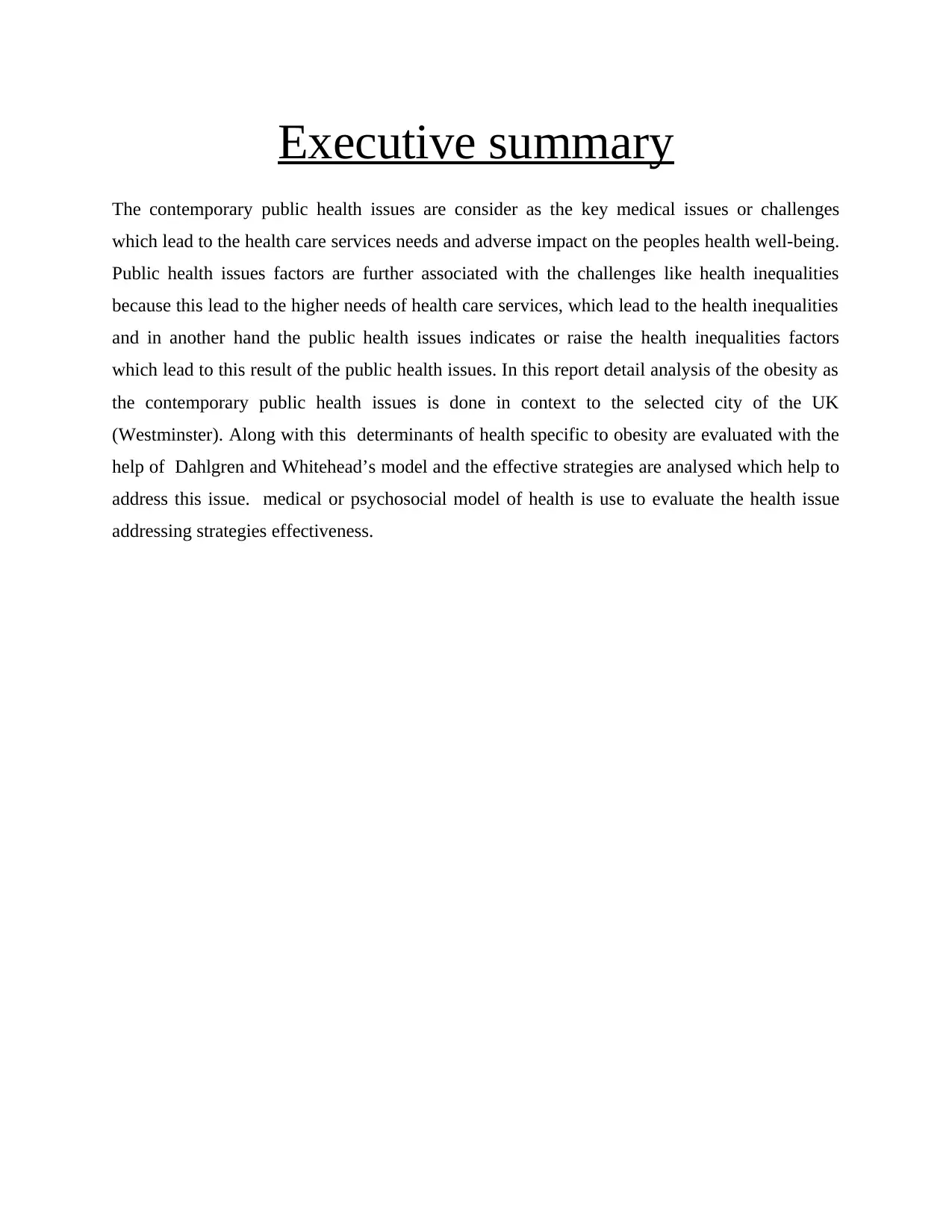
Executive summary
The contemporary public health issues are consider as the key medical issues or challenges
which lead to the health care services needs and adverse impact on the peoples health well-being.
Public health issues factors are further associated with the challenges like health inequalities
because this lead to the higher needs of health care services, which lead to the health inequalities
and in another hand the public health issues indicates or raise the health inequalities factors
which lead to this result of the public health issues. In this report detail analysis of the obesity as
the contemporary public health issues is done in context to the selected city of the UK
(Westminster). Along with this determinants of health specific to obesity are evaluated with the
help of Dahlgren and Whitehead’s model and the effective strategies are analysed which help to
address this issue. medical or psychosocial model of health is use to evaluate the health issue
addressing strategies effectiveness.
The contemporary public health issues are consider as the key medical issues or challenges
which lead to the health care services needs and adverse impact on the peoples health well-being.
Public health issues factors are further associated with the challenges like health inequalities
because this lead to the higher needs of health care services, which lead to the health inequalities
and in another hand the public health issues indicates or raise the health inequalities factors
which lead to this result of the public health issues. In this report detail analysis of the obesity as
the contemporary public health issues is done in context to the selected city of the UK
(Westminster). Along with this determinants of health specific to obesity are evaluated with the
help of Dahlgren and Whitehead’s model and the effective strategies are analysed which help to
address this issue. medical or psychosocial model of health is use to evaluate the health issue
addressing strategies effectiveness.
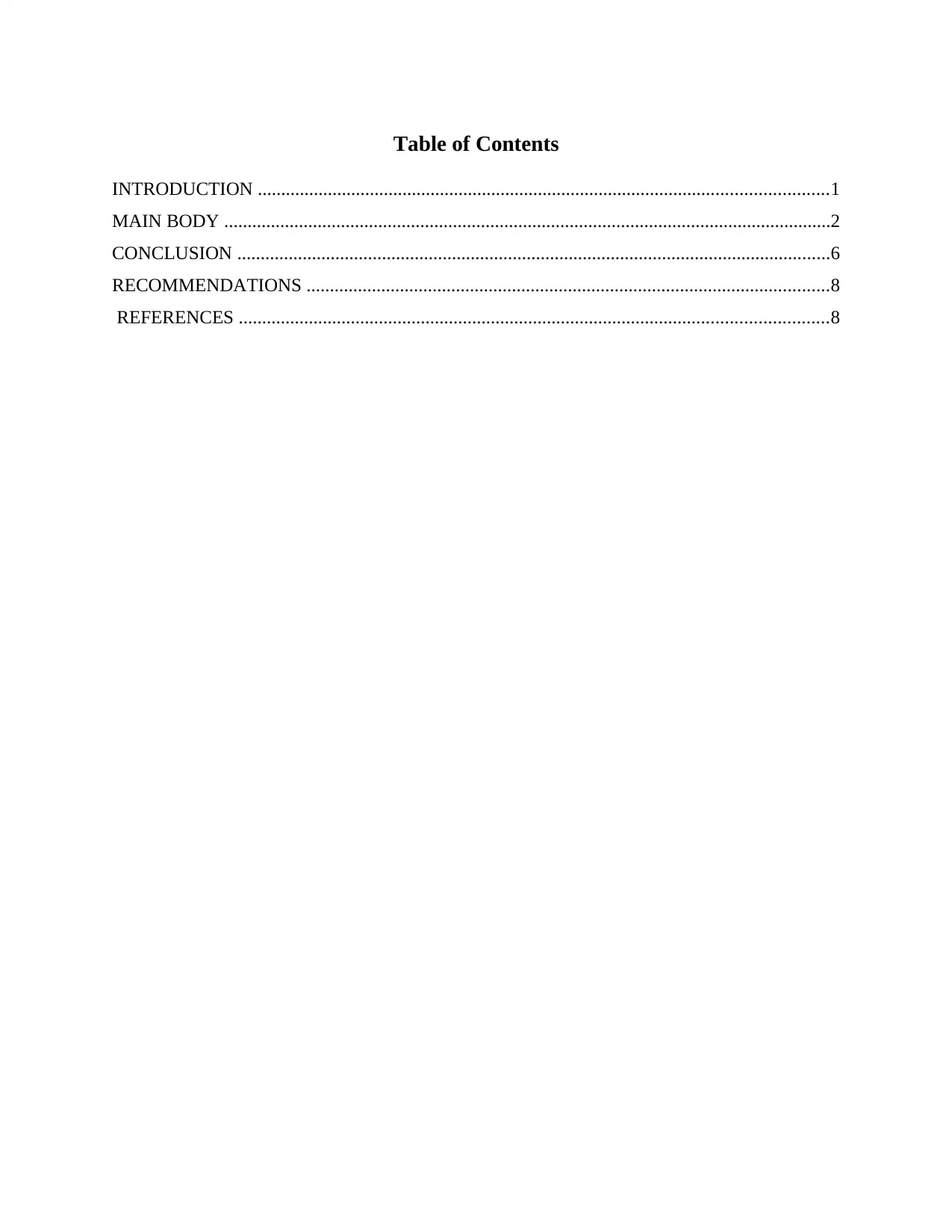
Table of Contents
INTRODUCTION ..........................................................................................................................1
MAIN BODY ..................................................................................................................................2
CONCLUSION ...............................................................................................................................6
RECOMMENDATIONS ................................................................................................................8
REFERENCES ..............................................................................................................................8
INTRODUCTION ..........................................................................................................................1
MAIN BODY ..................................................................................................................................2
CONCLUSION ...............................................................................................................................6
RECOMMENDATIONS ................................................................................................................8
REFERENCES ..............................................................................................................................8
⊘ This is a preview!⊘
Do you want full access?
Subscribe today to unlock all pages.

Trusted by 1+ million students worldwide
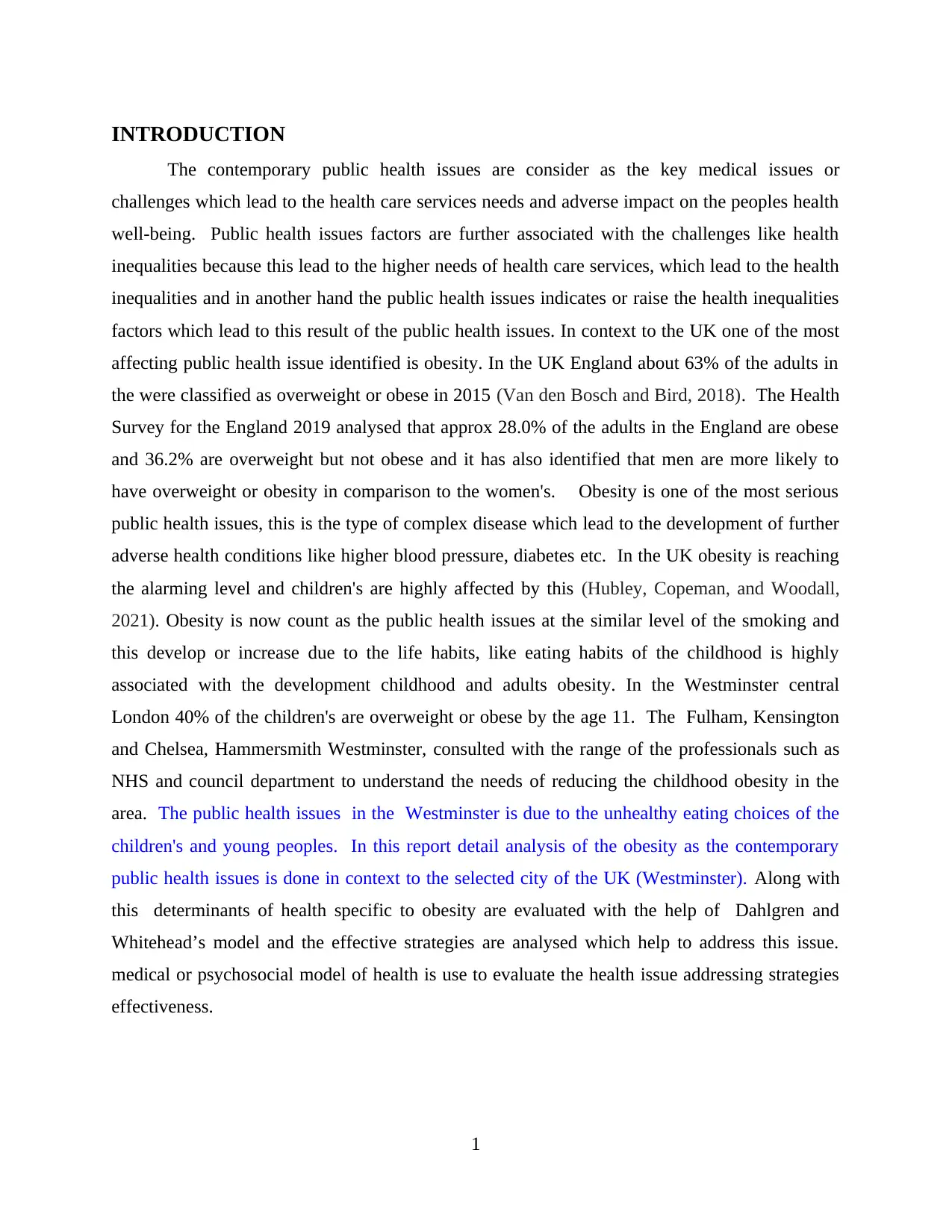
INTRODUCTION
The contemporary public health issues are consider as the key medical issues or
challenges which lead to the health care services needs and adverse impact on the peoples health
well-being. Public health issues factors are further associated with the challenges like health
inequalities because this lead to the higher needs of health care services, which lead to the health
inequalities and in another hand the public health issues indicates or raise the health inequalities
factors which lead to this result of the public health issues. In context to the UK one of the most
affecting public health issue identified is obesity. In the UK England about 63% of the adults in
the were classified as overweight or obese in 2015 (Van den Bosch and Bird, 2018). The Health
Survey for the England 2019 analysed that approx 28.0% of the adults in the England are obese
and 36.2% are overweight but not obese and it has also identified that men are more likely to
have overweight or obesity in comparison to the women's. Obesity is one of the most serious
public health issues, this is the type of complex disease which lead to the development of further
adverse health conditions like higher blood pressure, diabetes etc. In the UK obesity is reaching
the alarming level and children's are highly affected by this (Hubley, Copeman, and Woodall,
2021). Obesity is now count as the public health issues at the similar level of the smoking and
this develop or increase due to the life habits, like eating habits of the childhood is highly
associated with the development childhood and adults obesity. In the Westminster central
London 40% of the children's are overweight or obese by the age 11. The Fulham, Kensington
and Chelsea, Hammersmith Westminster, consulted with the range of the professionals such as
NHS and council department to understand the needs of reducing the childhood obesity in the
area. The public health issues in the Westminster is due to the unhealthy eating choices of the
children's and young peoples. In this report detail analysis of the obesity as the contemporary
public health issues is done in context to the selected city of the UK (Westminster). Along with
this determinants of health specific to obesity are evaluated with the help of Dahlgren and
Whitehead’s model and the effective strategies are analysed which help to address this issue.
medical or psychosocial model of health is use to evaluate the health issue addressing strategies
effectiveness.
1
The contemporary public health issues are consider as the key medical issues or
challenges which lead to the health care services needs and adverse impact on the peoples health
well-being. Public health issues factors are further associated with the challenges like health
inequalities because this lead to the higher needs of health care services, which lead to the health
inequalities and in another hand the public health issues indicates or raise the health inequalities
factors which lead to this result of the public health issues. In context to the UK one of the most
affecting public health issue identified is obesity. In the UK England about 63% of the adults in
the were classified as overweight or obese in 2015 (Van den Bosch and Bird, 2018). The Health
Survey for the England 2019 analysed that approx 28.0% of the adults in the England are obese
and 36.2% are overweight but not obese and it has also identified that men are more likely to
have overweight or obesity in comparison to the women's. Obesity is one of the most serious
public health issues, this is the type of complex disease which lead to the development of further
adverse health conditions like higher blood pressure, diabetes etc. In the UK obesity is reaching
the alarming level and children's are highly affected by this (Hubley, Copeman, and Woodall,
2021). Obesity is now count as the public health issues at the similar level of the smoking and
this develop or increase due to the life habits, like eating habits of the childhood is highly
associated with the development childhood and adults obesity. In the Westminster central
London 40% of the children's are overweight or obese by the age 11. The Fulham, Kensington
and Chelsea, Hammersmith Westminster, consulted with the range of the professionals such as
NHS and council department to understand the needs of reducing the childhood obesity in the
area. The public health issues in the Westminster is due to the unhealthy eating choices of the
children's and young peoples. In this report detail analysis of the obesity as the contemporary
public health issues is done in context to the selected city of the UK (Westminster). Along with
this determinants of health specific to obesity are evaluated with the help of Dahlgren and
Whitehead’s model and the effective strategies are analysed which help to address this issue.
medical or psychosocial model of health is use to evaluate the health issue addressing strategies
effectiveness.
1
Paraphrase This Document
Need a fresh take? Get an instant paraphrase of this document with our AI Paraphraser
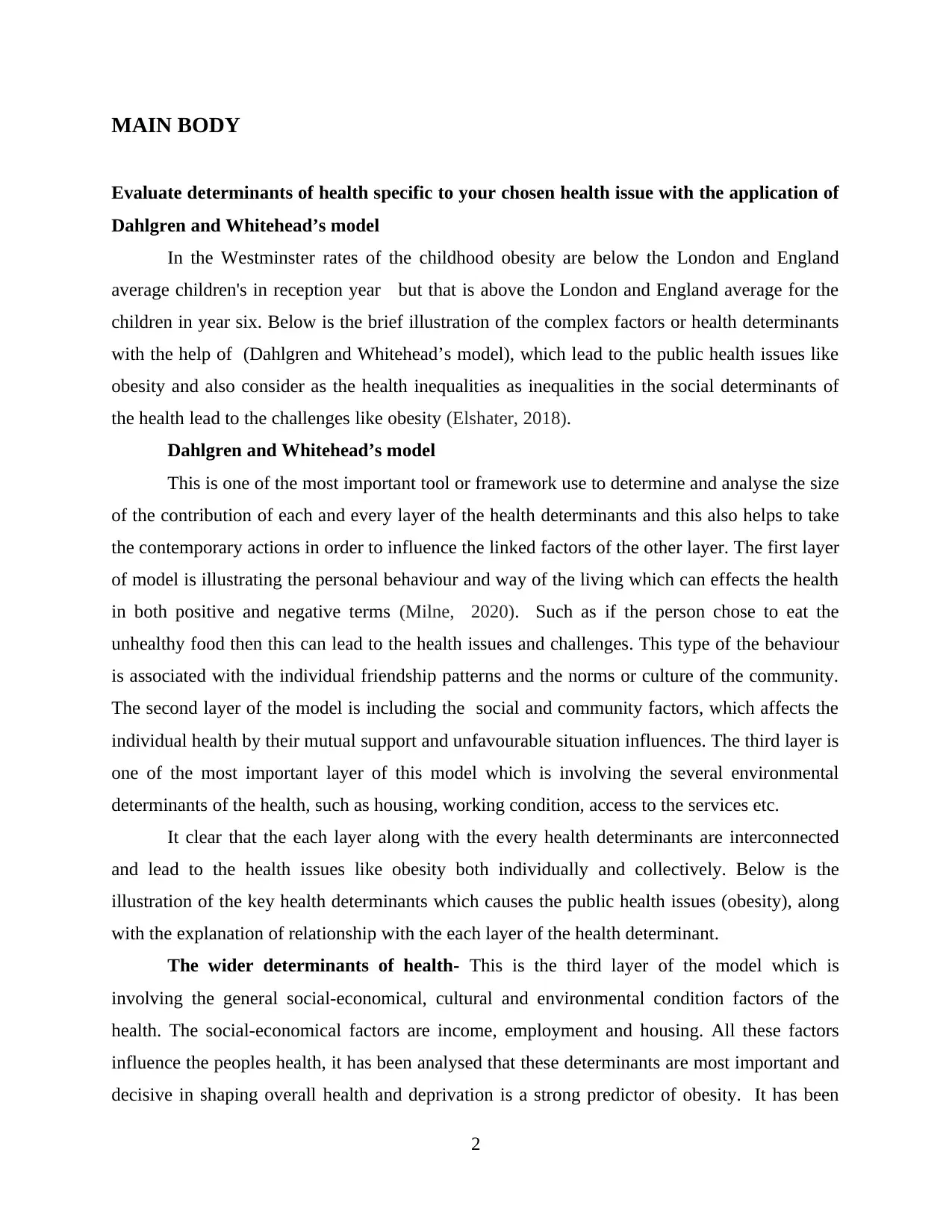
MAIN BODY
Evaluate determinants of health specific to your chosen health issue with the application of
Dahlgren and Whitehead’s model
In the Westminster rates of the childhood obesity are below the London and England
average children's in reception year but that is above the London and England average for the
children in year six. Below is the brief illustration of the complex factors or health determinants
with the help of (Dahlgren and Whitehead’s model), which lead to the public health issues like
obesity and also consider as the health inequalities as inequalities in the social determinants of
the health lead to the challenges like obesity (Elshater, 2018).
Dahlgren and Whitehead’s model
This is one of the most important tool or framework use to determine and analyse the size
of the contribution of each and every layer of the health determinants and this also helps to take
the contemporary actions in order to influence the linked factors of the other layer. The first layer
of model is illustrating the personal behaviour and way of the living which can effects the health
in both positive and negative terms (Milne, 2020). Such as if the person chose to eat the
unhealthy food then this can lead to the health issues and challenges. This type of the behaviour
is associated with the individual friendship patterns and the norms or culture of the community.
The second layer of the model is including the social and community factors, which affects the
individual health by their mutual support and unfavourable situation influences. The third layer is
one of the most important layer of this model which is involving the several environmental
determinants of the health, such as housing, working condition, access to the services etc.
It clear that the each layer along with the every health determinants are interconnected
and lead to the health issues like obesity both individually and collectively. Below is the
illustration of the key health determinants which causes the public health issues (obesity), along
with the explanation of relationship with the each layer of the health determinant.
The wider determinants of health- This is the third layer of the model which is
involving the general social-economical, cultural and environmental condition factors of the
health. The social-economical factors are income, employment and housing. All these factors
influence the peoples health, it has been analysed that these determinants are most important and
decisive in shaping overall health and deprivation is a strong predictor of obesity. It has been
2
Evaluate determinants of health specific to your chosen health issue with the application of
Dahlgren and Whitehead’s model
In the Westminster rates of the childhood obesity are below the London and England
average children's in reception year but that is above the London and England average for the
children in year six. Below is the brief illustration of the complex factors or health determinants
with the help of (Dahlgren and Whitehead’s model), which lead to the public health issues like
obesity and also consider as the health inequalities as inequalities in the social determinants of
the health lead to the challenges like obesity (Elshater, 2018).
Dahlgren and Whitehead’s model
This is one of the most important tool or framework use to determine and analyse the size
of the contribution of each and every layer of the health determinants and this also helps to take
the contemporary actions in order to influence the linked factors of the other layer. The first layer
of model is illustrating the personal behaviour and way of the living which can effects the health
in both positive and negative terms (Milne, 2020). Such as if the person chose to eat the
unhealthy food then this can lead to the health issues and challenges. This type of the behaviour
is associated with the individual friendship patterns and the norms or culture of the community.
The second layer of the model is including the social and community factors, which affects the
individual health by their mutual support and unfavourable situation influences. The third layer is
one of the most important layer of this model which is involving the several environmental
determinants of the health, such as housing, working condition, access to the services etc.
It clear that the each layer along with the every health determinants are interconnected
and lead to the health issues like obesity both individually and collectively. Below is the
illustration of the key health determinants which causes the public health issues (obesity), along
with the explanation of relationship with the each layer of the health determinant.
The wider determinants of health- This is the third layer of the model which is
involving the general social-economical, cultural and environmental condition factors of the
health. The social-economical factors are income, employment and housing. All these factors
influence the peoples health, it has been analysed that these determinants are most important and
decisive in shaping overall health and deprivation is a strong predictor of obesity. It has been
2
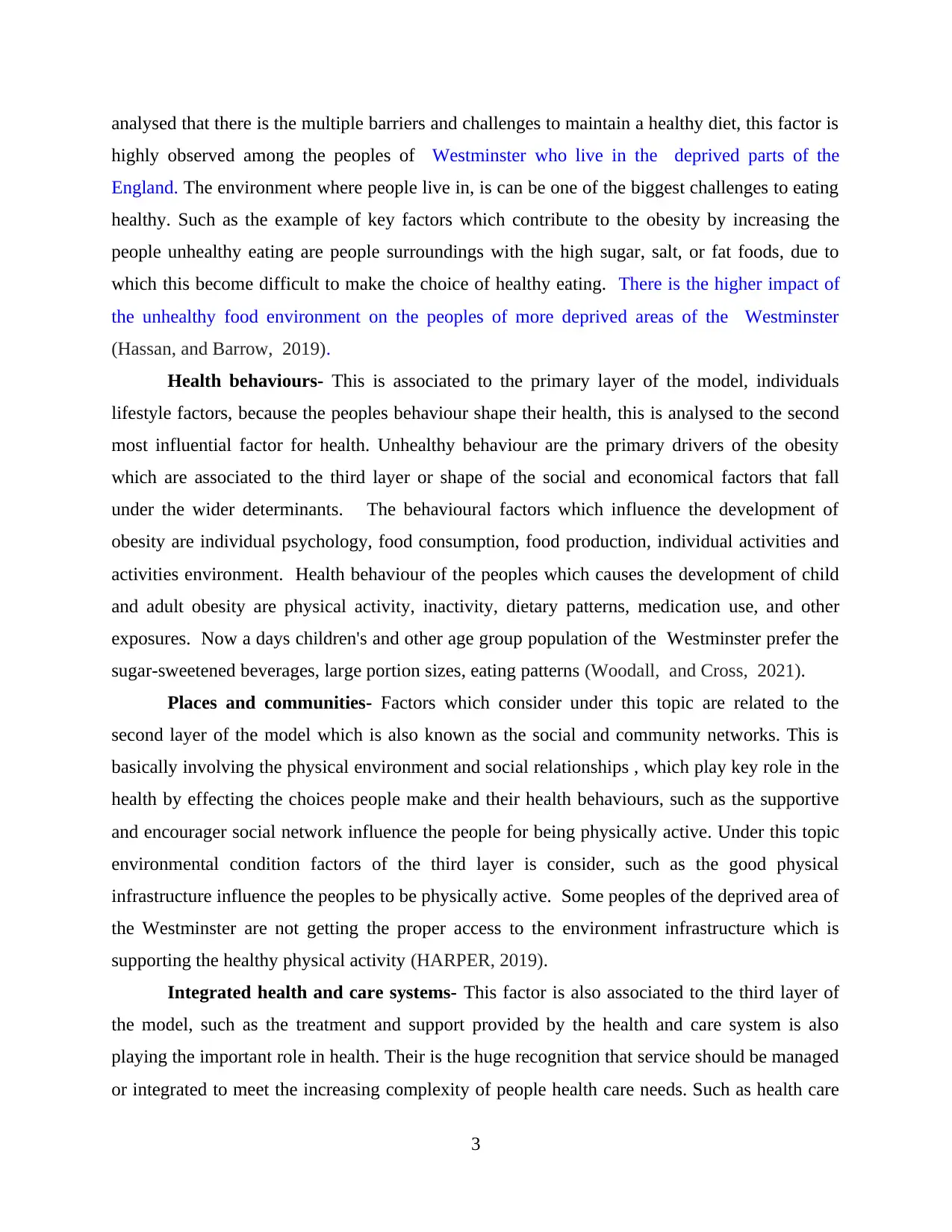
analysed that there is the multiple barriers and challenges to maintain a healthy diet, this factor is
highly observed among the peoples of Westminster who live in the deprived parts of the
England. The environment where people live in, is can be one of the biggest challenges to eating
healthy. Such as the example of key factors which contribute to the obesity by increasing the
people unhealthy eating are people surroundings with the high sugar, salt, or fat foods, due to
which this become difficult to make the choice of healthy eating. There is the higher impact of
the unhealthy food environment on the peoples of more deprived areas of the Westminster
(Hassan, and Barrow, 2019).
Health behaviours- This is associated to the primary layer of the model, individuals
lifestyle factors, because the peoples behaviour shape their health, this is analysed to the second
most influential factor for health. Unhealthy behaviour are the primary drivers of the obesity
which are associated to the third layer or shape of the social and economical factors that fall
under the wider determinants. The behavioural factors which influence the development of
obesity are individual psychology, food consumption, food production, individual activities and
activities environment. Health behaviour of the peoples which causes the development of child
and adult obesity are physical activity, inactivity, dietary patterns, medication use, and other
exposures. Now a days children's and other age group population of the Westminster prefer the
sugar-sweetened beverages, large portion sizes, eating patterns (Woodall, and Cross, 2021).
Places and communities- Factors which consider under this topic are related to the
second layer of the model which is also known as the social and community networks. This is
basically involving the physical environment and social relationships , which play key role in the
health by effecting the choices people make and their health behaviours, such as the supportive
and encourager social network influence the people for being physically active. Under this topic
environmental condition factors of the third layer is consider, such as the good physical
infrastructure influence the peoples to be physically active. Some peoples of the deprived area of
the Westminster are not getting the proper access to the environment infrastructure which is
supporting the healthy physical activity (HARPER, 2019).
Integrated health and care systems- This factor is also associated to the third layer of
the model, such as the treatment and support provided by the health and care system is also
playing the important role in health. Their is the huge recognition that service should be managed
or integrated to meet the increasing complexity of people health care needs. Such as health care
3
highly observed among the peoples of Westminster who live in the deprived parts of the
England. The environment where people live in, is can be one of the biggest challenges to eating
healthy. Such as the example of key factors which contribute to the obesity by increasing the
people unhealthy eating are people surroundings with the high sugar, salt, or fat foods, due to
which this become difficult to make the choice of healthy eating. There is the higher impact of
the unhealthy food environment on the peoples of more deprived areas of the Westminster
(Hassan, and Barrow, 2019).
Health behaviours- This is associated to the primary layer of the model, individuals
lifestyle factors, because the peoples behaviour shape their health, this is analysed to the second
most influential factor for health. Unhealthy behaviour are the primary drivers of the obesity
which are associated to the third layer or shape of the social and economical factors that fall
under the wider determinants. The behavioural factors which influence the development of
obesity are individual psychology, food consumption, food production, individual activities and
activities environment. Health behaviour of the peoples which causes the development of child
and adult obesity are physical activity, inactivity, dietary patterns, medication use, and other
exposures. Now a days children's and other age group population of the Westminster prefer the
sugar-sweetened beverages, large portion sizes, eating patterns (Woodall, and Cross, 2021).
Places and communities- Factors which consider under this topic are related to the
second layer of the model which is also known as the social and community networks. This is
basically involving the physical environment and social relationships , which play key role in the
health by effecting the choices people make and their health behaviours, such as the supportive
and encourager social network influence the people for being physically active. Under this topic
environmental condition factors of the third layer is consider, such as the good physical
infrastructure influence the peoples to be physically active. Some peoples of the deprived area of
the Westminster are not getting the proper access to the environment infrastructure which is
supporting the healthy physical activity (HARPER, 2019).
Integrated health and care systems- This factor is also associated to the third layer of
the model, such as the treatment and support provided by the health and care system is also
playing the important role in health. Their is the huge recognition that service should be managed
or integrated to meet the increasing complexity of people health care needs. Such as health care
3
⊘ This is a preview!⊘
Do you want full access?
Subscribe today to unlock all pages.

Trusted by 1+ million students worldwide
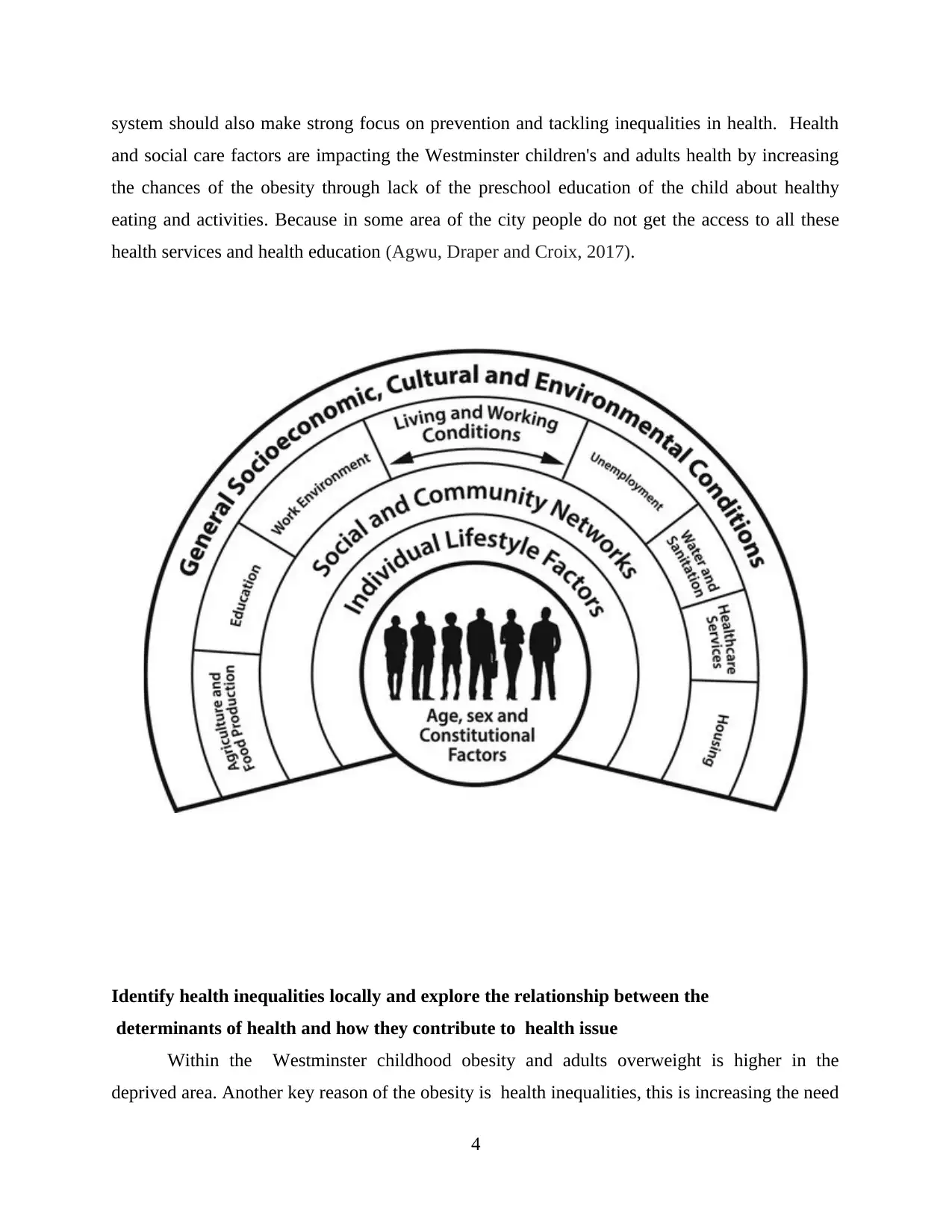
system should also make strong focus on prevention and tackling inequalities in health. Health
and social care factors are impacting the Westminster children's and adults health by increasing
the chances of the obesity through lack of the preschool education of the child about healthy
eating and activities. Because in some area of the city people do not get the access to all these
health services and health education (Agwu, Draper and Croix, 2017).
Identify health inequalities locally and explore the relationship between the
determinants of health and how they contribute to health issue
Within the Westminster childhood obesity and adults overweight is higher in the
deprived area. Another key reason of the obesity is health inequalities, this is increasing the need
4
and social care factors are impacting the Westminster children's and adults health by increasing
the chances of the obesity through lack of the preschool education of the child about healthy
eating and activities. Because in some area of the city people do not get the access to all these
health services and health education (Agwu, Draper and Croix, 2017).
Identify health inequalities locally and explore the relationship between the
determinants of health and how they contribute to health issue
Within the Westminster childhood obesity and adults overweight is higher in the
deprived area. Another key reason of the obesity is health inequalities, this is increasing the need
4
Paraphrase This Document
Need a fresh take? Get an instant paraphrase of this document with our AI Paraphraser
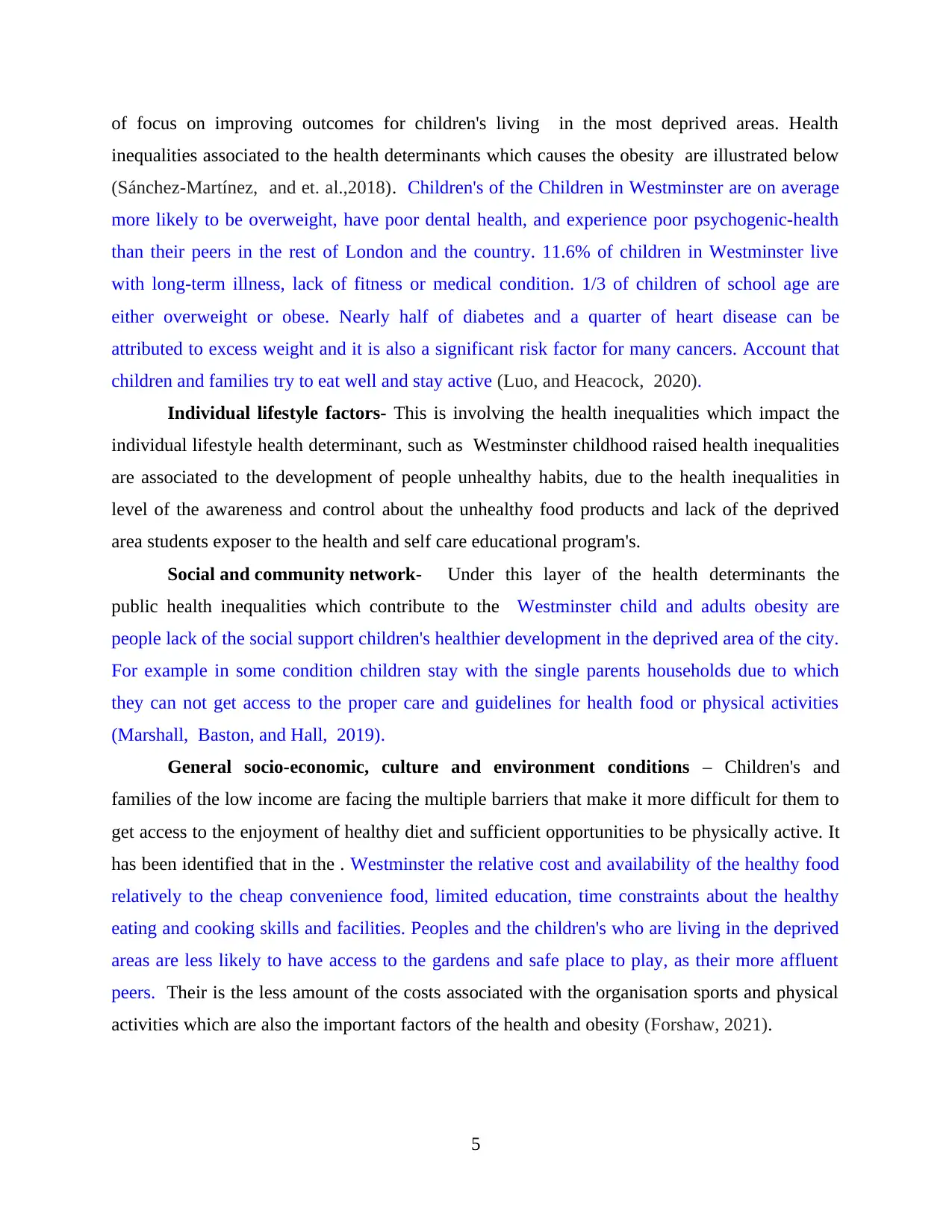
of focus on improving outcomes for children's living in the most deprived areas. Health
inequalities associated to the health determinants which causes the obesity are illustrated below
(Sánchez-Martínez, and et. al.,2018). Children's of the Children in Westminster are on average
more likely to be overweight, have poor dental health, and experience poor psychogenic-health
than their peers in the rest of London and the country. 11.6% of children in Westminster live
with long-term illness, lack of fitness or medical condition. 1/3 of children of school age are
either overweight or obese. Nearly half of diabetes and a quarter of heart disease can be
attributed to excess weight and it is also a significant risk factor for many cancers. Account that
children and families try to eat well and stay active (Luo, and Heacock, 2020).
Individual lifestyle factors- This is involving the health inequalities which impact the
individual lifestyle health determinant, such as Westminster childhood raised health inequalities
are associated to the development of people unhealthy habits, due to the health inequalities in
level of the awareness and control about the unhealthy food products and lack of the deprived
area students exposer to the health and self care educational program's.
Social and community network- Under this layer of the health determinants the
public health inequalities which contribute to the Westminster child and adults obesity are
people lack of the social support children's healthier development in the deprived area of the city.
For example in some condition children stay with the single parents households due to which
they can not get access to the proper care and guidelines for health food or physical activities
(Marshall, Baston, and Hall, 2019).
General socio-economic, culture and environment conditions – Children's and
families of the low income are facing the multiple barriers that make it more difficult for them to
get access to the enjoyment of healthy diet and sufficient opportunities to be physically active. It
has been identified that in the . Westminster the relative cost and availability of the healthy food
relatively to the cheap convenience food, limited education, time constraints about the healthy
eating and cooking skills and facilities. Peoples and the children's who are living in the deprived
areas are less likely to have access to the gardens and safe place to play, as their more affluent
peers. Their is the less amount of the costs associated with the organisation sports and physical
activities which are also the important factors of the health and obesity (Forshaw, 2021).
5
inequalities associated to the health determinants which causes the obesity are illustrated below
(Sánchez-Martínez, and et. al.,2018). Children's of the Children in Westminster are on average
more likely to be overweight, have poor dental health, and experience poor psychogenic-health
than their peers in the rest of London and the country. 11.6% of children in Westminster live
with long-term illness, lack of fitness or medical condition. 1/3 of children of school age are
either overweight or obese. Nearly half of diabetes and a quarter of heart disease can be
attributed to excess weight and it is also a significant risk factor for many cancers. Account that
children and families try to eat well and stay active (Luo, and Heacock, 2020).
Individual lifestyle factors- This is involving the health inequalities which impact the
individual lifestyle health determinant, such as Westminster childhood raised health inequalities
are associated to the development of people unhealthy habits, due to the health inequalities in
level of the awareness and control about the unhealthy food products and lack of the deprived
area students exposer to the health and self care educational program's.
Social and community network- Under this layer of the health determinants the
public health inequalities which contribute to the Westminster child and adults obesity are
people lack of the social support children's healthier development in the deprived area of the city.
For example in some condition children stay with the single parents households due to which
they can not get access to the proper care and guidelines for health food or physical activities
(Marshall, Baston, and Hall, 2019).
General socio-economic, culture and environment conditions – Children's and
families of the low income are facing the multiple barriers that make it more difficult for them to
get access to the enjoyment of healthy diet and sufficient opportunities to be physically active. It
has been identified that in the . Westminster the relative cost and availability of the healthy food
relatively to the cheap convenience food, limited education, time constraints about the healthy
eating and cooking skills and facilities. Peoples and the children's who are living in the deprived
areas are less likely to have access to the gardens and safe place to play, as their more affluent
peers. Their is the less amount of the costs associated with the organisation sports and physical
activities which are also the important factors of the health and obesity (Forshaw, 2021).
5
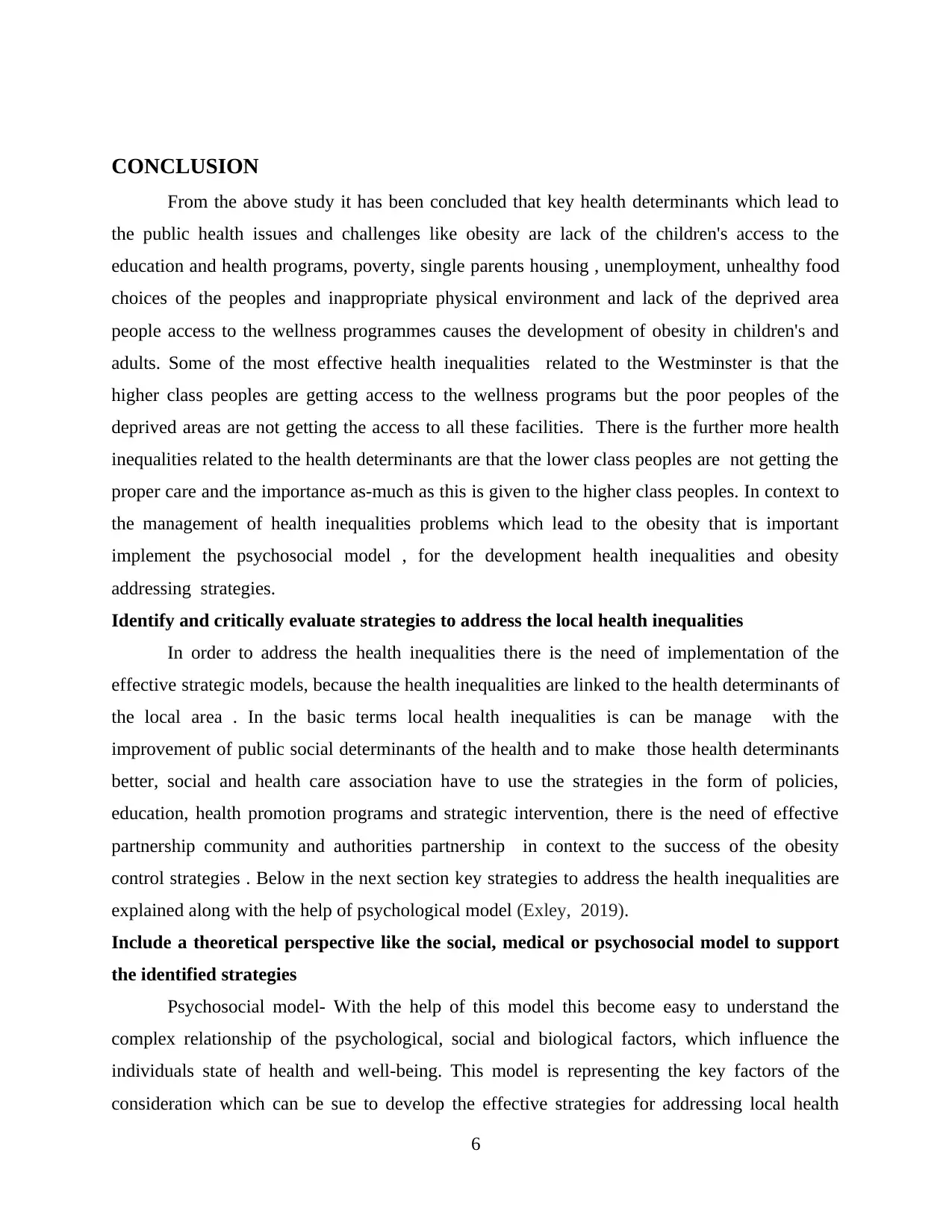
CONCLUSION
From the above study it has been concluded that key health determinants which lead to
the public health issues and challenges like obesity are lack of the children's access to the
education and health programs, poverty, single parents housing , unemployment, unhealthy food
choices of the peoples and inappropriate physical environment and lack of the deprived area
people access to the wellness programmes causes the development of obesity in children's and
adults. Some of the most effective health inequalities related to the Westminster is that the
higher class peoples are getting access to the wellness programs but the poor peoples of the
deprived areas are not getting the access to all these facilities. There is the further more health
inequalities related to the health determinants are that the lower class peoples are not getting the
proper care and the importance as-much as this is given to the higher class peoples. In context to
the management of health inequalities problems which lead to the obesity that is important
implement the psychosocial model , for the development health inequalities and obesity
addressing strategies.
Identify and critically evaluate strategies to address the local health inequalities
In order to address the health inequalities there is the need of implementation of the
effective strategic models, because the health inequalities are linked to the health determinants of
the local area . In the basic terms local health inequalities is can be manage with the
improvement of public social determinants of the health and to make those health determinants
better, social and health care association have to use the strategies in the form of policies,
education, health promotion programs and strategic intervention, there is the need of effective
partnership community and authorities partnership in context to the success of the obesity
control strategies . Below in the next section key strategies to address the health inequalities are
explained along with the help of psychological model (Exley, 2019).
Include a theoretical perspective like the social, medical or psychosocial model to support
the identified strategies
Psychosocial model- With the help of this model this become easy to understand the
complex relationship of the psychological, social and biological factors, which influence the
individuals state of health and well-being. This model is representing the key factors of the
consideration which can be sue to develop the effective strategies for addressing local health
6
From the above study it has been concluded that key health determinants which lead to
the public health issues and challenges like obesity are lack of the children's access to the
education and health programs, poverty, single parents housing , unemployment, unhealthy food
choices of the peoples and inappropriate physical environment and lack of the deprived area
people access to the wellness programmes causes the development of obesity in children's and
adults. Some of the most effective health inequalities related to the Westminster is that the
higher class peoples are getting access to the wellness programs but the poor peoples of the
deprived areas are not getting the access to all these facilities. There is the further more health
inequalities related to the health determinants are that the lower class peoples are not getting the
proper care and the importance as-much as this is given to the higher class peoples. In context to
the management of health inequalities problems which lead to the obesity that is important
implement the psychosocial model , for the development health inequalities and obesity
addressing strategies.
Identify and critically evaluate strategies to address the local health inequalities
In order to address the health inequalities there is the need of implementation of the
effective strategic models, because the health inequalities are linked to the health determinants of
the local area . In the basic terms local health inequalities is can be manage with the
improvement of public social determinants of the health and to make those health determinants
better, social and health care association have to use the strategies in the form of policies,
education, health promotion programs and strategic intervention, there is the need of effective
partnership community and authorities partnership in context to the success of the obesity
control strategies . Below in the next section key strategies to address the health inequalities are
explained along with the help of psychological model (Exley, 2019).
Include a theoretical perspective like the social, medical or psychosocial model to support
the identified strategies
Psychosocial model- With the help of this model this become easy to understand the
complex relationship of the psychological, social and biological factors, which influence the
individuals state of health and well-being. This model is representing the key factors of the
consideration which can be sue to develop the effective strategies for addressing local health
6
⊘ This is a preview!⊘
Do you want full access?
Subscribe today to unlock all pages.

Trusted by 1+ million students worldwide
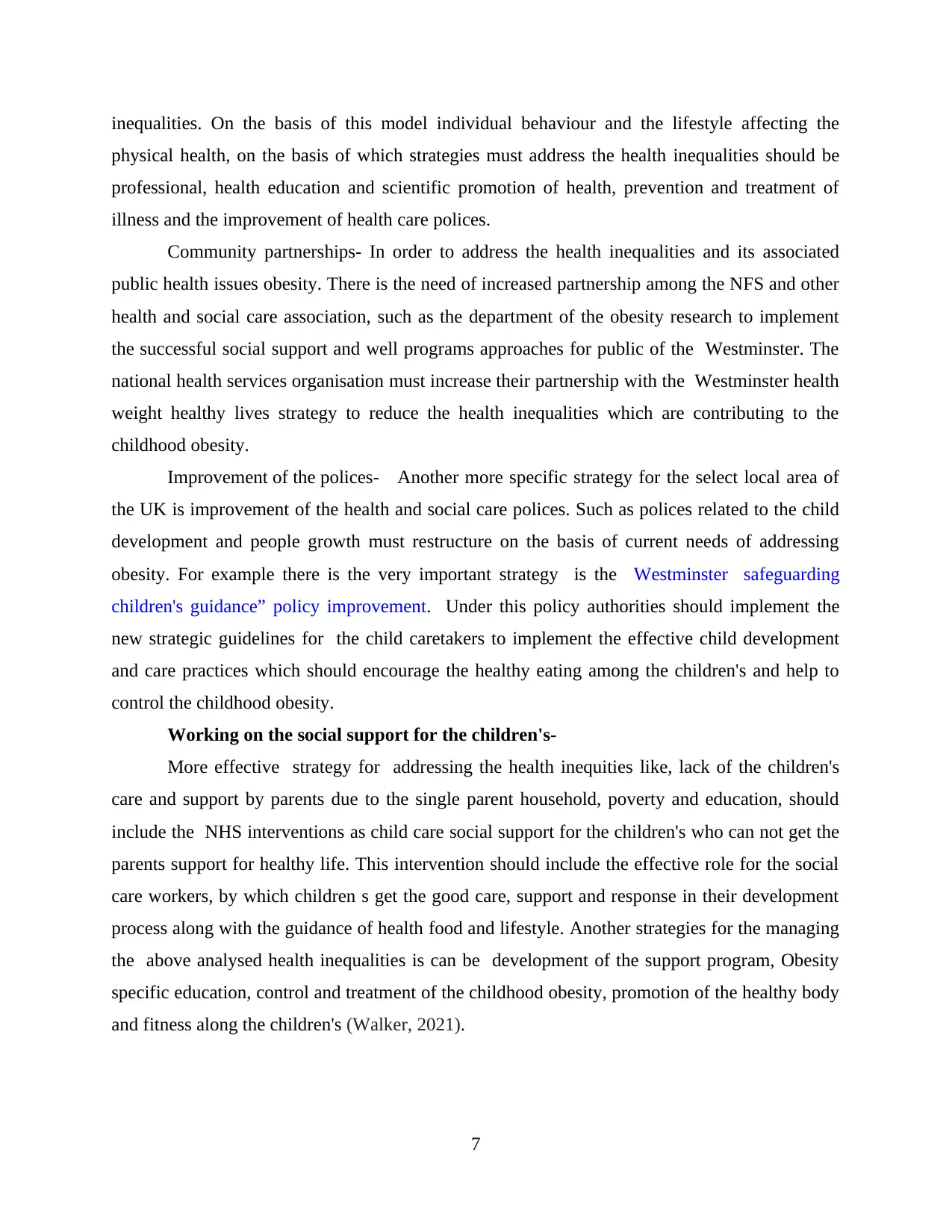
inequalities. On the basis of this model individual behaviour and the lifestyle affecting the
physical health, on the basis of which strategies must address the health inequalities should be
professional, health education and scientific promotion of health, prevention and treatment of
illness and the improvement of health care polices.
Community partnerships- In order to address the health inequalities and its associated
public health issues obesity. There is the need of increased partnership among the NFS and other
health and social care association, such as the department of the obesity research to implement
the successful social support and well programs approaches for public of the Westminster. The
national health services organisation must increase their partnership with the Westminster health
weight healthy lives strategy to reduce the health inequalities which are contributing to the
childhood obesity.
Improvement of the polices- Another more specific strategy for the select local area of
the UK is improvement of the health and social care polices. Such as polices related to the child
development and people growth must restructure on the basis of current needs of addressing
obesity. For example there is the very important strategy is the Westminster safeguarding
children's guidance” policy improvement. Under this policy authorities should implement the
new strategic guidelines for the child caretakers to implement the effective child development
and care practices which should encourage the healthy eating among the children's and help to
control the childhood obesity.
Working on the social support for the children's-
More effective strategy for addressing the health inequities like, lack of the children's
care and support by parents due to the single parent household, poverty and education, should
include the NHS interventions as child care social support for the children's who can not get the
parents support for healthy life. This intervention should include the effective role for the social
care workers, by which children s get the good care, support and response in their development
process along with the guidance of health food and lifestyle. Another strategies for the managing
the above analysed health inequalities is can be development of the support program, Obesity
specific education, control and treatment of the childhood obesity, promotion of the healthy body
and fitness along the children's (Walker, 2021).
7
physical health, on the basis of which strategies must address the health inequalities should be
professional, health education and scientific promotion of health, prevention and treatment of
illness and the improvement of health care polices.
Community partnerships- In order to address the health inequalities and its associated
public health issues obesity. There is the need of increased partnership among the NFS and other
health and social care association, such as the department of the obesity research to implement
the successful social support and well programs approaches for public of the Westminster. The
national health services organisation must increase their partnership with the Westminster health
weight healthy lives strategy to reduce the health inequalities which are contributing to the
childhood obesity.
Improvement of the polices- Another more specific strategy for the select local area of
the UK is improvement of the health and social care polices. Such as polices related to the child
development and people growth must restructure on the basis of current needs of addressing
obesity. For example there is the very important strategy is the Westminster safeguarding
children's guidance” policy improvement. Under this policy authorities should implement the
new strategic guidelines for the child caretakers to implement the effective child development
and care practices which should encourage the healthy eating among the children's and help to
control the childhood obesity.
Working on the social support for the children's-
More effective strategy for addressing the health inequities like, lack of the children's
care and support by parents due to the single parent household, poverty and education, should
include the NHS interventions as child care social support for the children's who can not get the
parents support for healthy life. This intervention should include the effective role for the social
care workers, by which children s get the good care, support and response in their development
process along with the guidance of health food and lifestyle. Another strategies for the managing
the above analysed health inequalities is can be development of the support program, Obesity
specific education, control and treatment of the childhood obesity, promotion of the healthy body
and fitness along the children's (Walker, 2021).
7
Paraphrase This Document
Need a fresh take? Get an instant paraphrase of this document with our AI Paraphraser
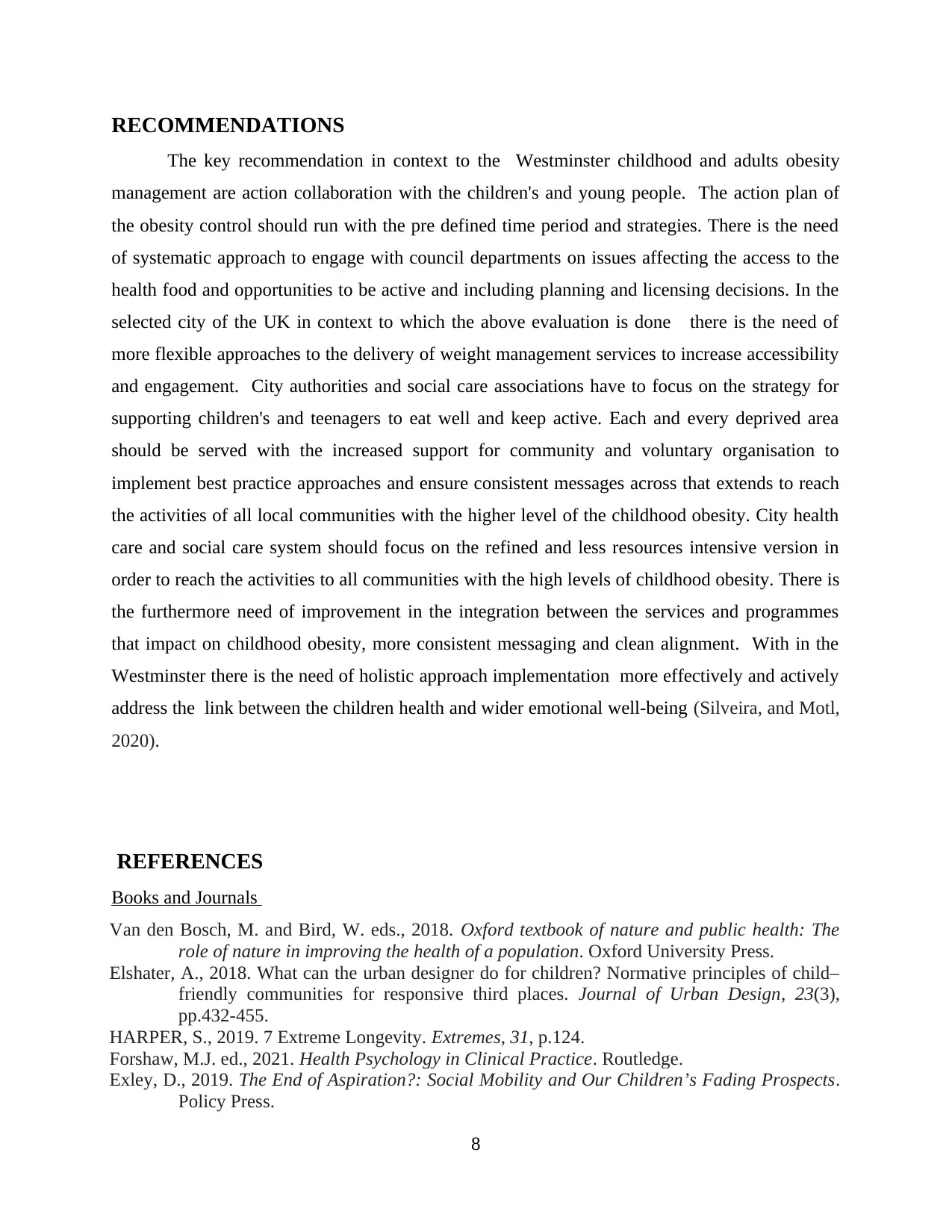
RECOMMENDATIONS
The key recommendation in context to the Westminster childhood and adults obesity
management are action collaboration with the children's and young people. The action plan of
the obesity control should run with the pre defined time period and strategies. There is the need
of systematic approach to engage with council departments on issues affecting the access to the
health food and opportunities to be active and including planning and licensing decisions. In the
selected city of the UK in context to which the above evaluation is done there is the need of
more flexible approaches to the delivery of weight management services to increase accessibility
and engagement. City authorities and social care associations have to focus on the strategy for
supporting children's and teenagers to eat well and keep active. Each and every deprived area
should be served with the increased support for community and voluntary organisation to
implement best practice approaches and ensure consistent messages across that extends to reach
the activities of all local communities with the higher level of the childhood obesity. City health
care and social care system should focus on the refined and less resources intensive version in
order to reach the activities to all communities with the high levels of childhood obesity. There is
the furthermore need of improvement in the integration between the services and programmes
that impact on childhood obesity, more consistent messaging and clean alignment. With in the
Westminster there is the need of holistic approach implementation more effectively and actively
address the link between the children health and wider emotional well-being (Silveira, and Motl,
2020).
REFERENCES
Books and Journals
Van den Bosch, M. and Bird, W. eds., 2018. Oxford textbook of nature and public health: The
role of nature in improving the health of a population. Oxford University Press.
Elshater, A., 2018. What can the urban designer do for children? Normative principles of child–
friendly communities for responsive third places. Journal of Urban Design, 23(3),
pp.432-455.
HARPER, S., 2019. 7 Extreme Longevity. Extremes, 31, p.124.
Forshaw, M.J. ed., 2021. Health Psychology in Clinical Practice. Routledge.
Exley, D., 2019. The End of Aspiration?: Social Mobility and Our Children’s Fading Prospects.
Policy Press.
8
The key recommendation in context to the Westminster childhood and adults obesity
management are action collaboration with the children's and young people. The action plan of
the obesity control should run with the pre defined time period and strategies. There is the need
of systematic approach to engage with council departments on issues affecting the access to the
health food and opportunities to be active and including planning and licensing decisions. In the
selected city of the UK in context to which the above evaluation is done there is the need of
more flexible approaches to the delivery of weight management services to increase accessibility
and engagement. City authorities and social care associations have to focus on the strategy for
supporting children's and teenagers to eat well and keep active. Each and every deprived area
should be served with the increased support for community and voluntary organisation to
implement best practice approaches and ensure consistent messages across that extends to reach
the activities of all local communities with the higher level of the childhood obesity. City health
care and social care system should focus on the refined and less resources intensive version in
order to reach the activities to all communities with the high levels of childhood obesity. There is
the furthermore need of improvement in the integration between the services and programmes
that impact on childhood obesity, more consistent messaging and clean alignment. With in the
Westminster there is the need of holistic approach implementation more effectively and actively
address the link between the children health and wider emotional well-being (Silveira, and Motl,
2020).
REFERENCES
Books and Journals
Van den Bosch, M. and Bird, W. eds., 2018. Oxford textbook of nature and public health: The
role of nature in improving the health of a population. Oxford University Press.
Elshater, A., 2018. What can the urban designer do for children? Normative principles of child–
friendly communities for responsive third places. Journal of Urban Design, 23(3),
pp.432-455.
HARPER, S., 2019. 7 Extreme Longevity. Extremes, 31, p.124.
Forshaw, M.J. ed., 2021. Health Psychology in Clinical Practice. Routledge.
Exley, D., 2019. The End of Aspiration?: Social Mobility and Our Children’s Fading Prospects.
Policy Press.
8
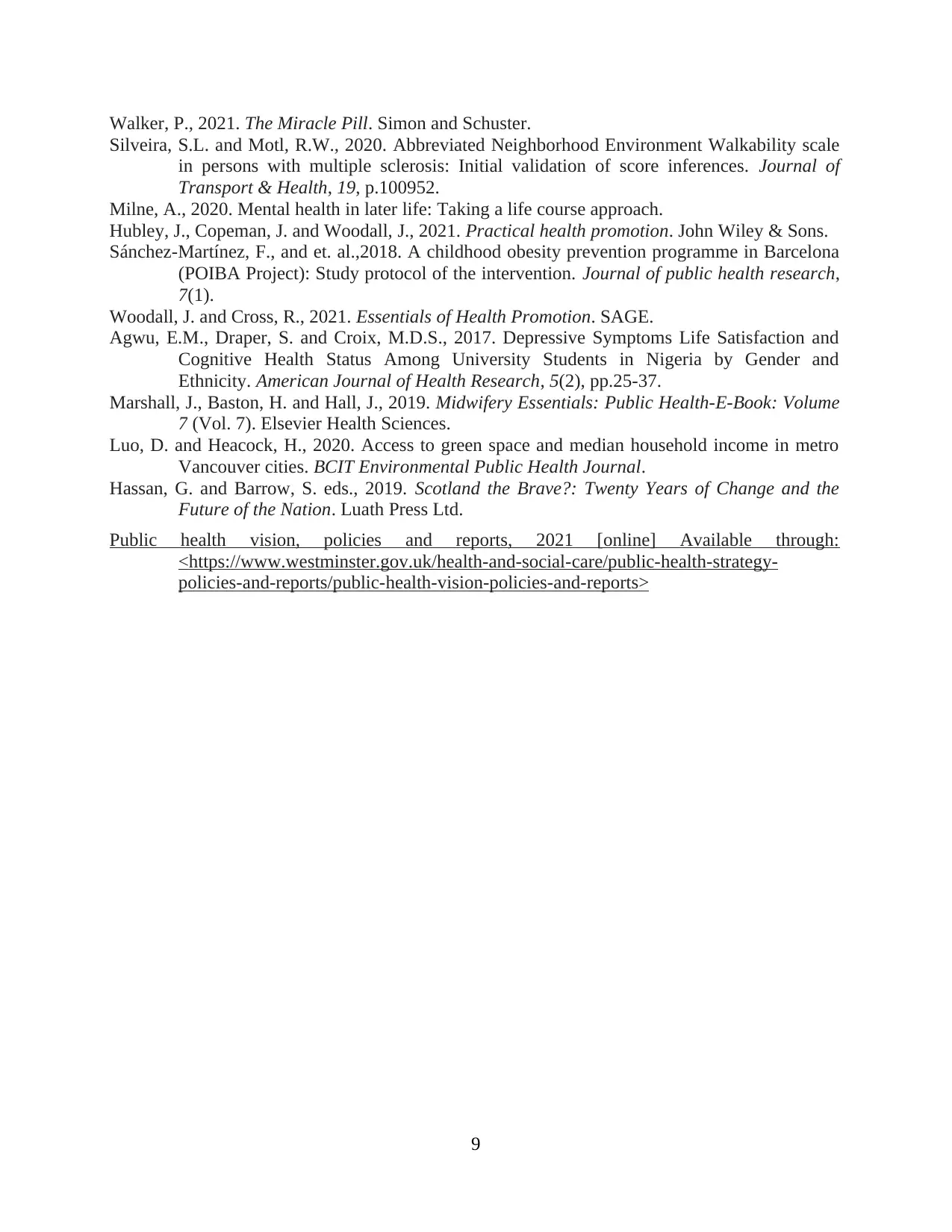
Walker, P., 2021. The Miracle Pill. Simon and Schuster.
Silveira, S.L. and Motl, R.W., 2020. Abbreviated Neighborhood Environment Walkability scale
in persons with multiple sclerosis: Initial validation of score inferences. Journal of
Transport & Health, 19, p.100952.
Milne, A., 2020. Mental health in later life: Taking a life course approach.
Hubley, J., Copeman, J. and Woodall, J., 2021. Practical health promotion. John Wiley & Sons.
Sánchez-Martínez, F., and et. al.,2018. A childhood obesity prevention programme in Barcelona
(POIBA Project): Study protocol of the intervention. Journal of public health research,
7(1).
Woodall, J. and Cross, R., 2021. Essentials of Health Promotion. SAGE.
Agwu, E.M., Draper, S. and Croix, M.D.S., 2017. Depressive Symptoms Life Satisfaction and
Cognitive Health Status Among University Students in Nigeria by Gender and
Ethnicity. American Journal of Health Research, 5(2), pp.25-37.
Marshall, J., Baston, H. and Hall, J., 2019. Midwifery Essentials: Public Health-E-Book: Volume
7 (Vol. 7). Elsevier Health Sciences.
Luo, D. and Heacock, H., 2020. Access to green space and median household income in metro
Vancouver cities. BCIT Environmental Public Health Journal.
Hassan, G. and Barrow, S. eds., 2019. Scotland the Brave?: Twenty Years of Change and the
Future of the Nation. Luath Press Ltd.
Public health vision, policies and reports, 2021 [online] Available through:
<https://www.westminster.gov.uk/health-and-social-care/public-health-strategy-
policies-and-reports/public-health-vision-policies-and-reports>
9
Silveira, S.L. and Motl, R.W., 2020. Abbreviated Neighborhood Environment Walkability scale
in persons with multiple sclerosis: Initial validation of score inferences. Journal of
Transport & Health, 19, p.100952.
Milne, A., 2020. Mental health in later life: Taking a life course approach.
Hubley, J., Copeman, J. and Woodall, J., 2021. Practical health promotion. John Wiley & Sons.
Sánchez-Martínez, F., and et. al.,2018. A childhood obesity prevention programme in Barcelona
(POIBA Project): Study protocol of the intervention. Journal of public health research,
7(1).
Woodall, J. and Cross, R., 2021. Essentials of Health Promotion. SAGE.
Agwu, E.M., Draper, S. and Croix, M.D.S., 2017. Depressive Symptoms Life Satisfaction and
Cognitive Health Status Among University Students in Nigeria by Gender and
Ethnicity. American Journal of Health Research, 5(2), pp.25-37.
Marshall, J., Baston, H. and Hall, J., 2019. Midwifery Essentials: Public Health-E-Book: Volume
7 (Vol. 7). Elsevier Health Sciences.
Luo, D. and Heacock, H., 2020. Access to green space and median household income in metro
Vancouver cities. BCIT Environmental Public Health Journal.
Hassan, G. and Barrow, S. eds., 2019. Scotland the Brave?: Twenty Years of Change and the
Future of the Nation. Luath Press Ltd.
Public health vision, policies and reports, 2021 [online] Available through:
<https://www.westminster.gov.uk/health-and-social-care/public-health-strategy-
policies-and-reports/public-health-vision-policies-and-reports>
9
⊘ This is a preview!⊘
Do you want full access?
Subscribe today to unlock all pages.

Trusted by 1+ million students worldwide
1 out of 13
Related Documents
Your All-in-One AI-Powered Toolkit for Academic Success.
+13062052269
info@desklib.com
Available 24*7 on WhatsApp / Email
![[object Object]](/_next/static/media/star-bottom.7253800d.svg)
Unlock your academic potential
Copyright © 2020–2025 A2Z Services. All Rights Reserved. Developed and managed by ZUCOL.





